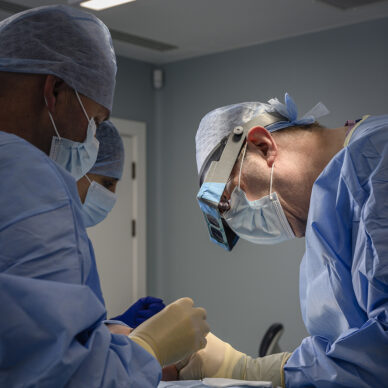Surgical Procedure
You will be treated by a consultant surgeon who is specially trained in Mohs surgery, pathology, and reconstructive surgery. The surgeon may mark your skin with guide lines to highlight the lesion before administering a local anaesthetic.
The surgeon will remove a layer of cancerous tissue, after which your wound will be temporarily dressed. You will then have a break while the surgeon colour-codes the tissue to create an orientation map.
A technician will freeze the tissue, slice it into thin sections, and place them onto slides. These sections will be examined under a microscope by the surgeon to check for any remaining cancer cells.
If cancer cells are found, they are pinpointed on the map, and you will return to the operating room. Further anaesthetic may not be required but can be applied, before the surgeon precisely removes another layer of tissue, only where the cancer cells remain.
This process is repeated, usually only a few times, until the margins of the last removed tissue sample are entirely cancer-free. The wound is then typically closed with stitches or, if necessary, other cosmetic techniques.
Post Operative Support
Mohs micrographic surgeons are skilled in tissue reconstruction. In cases where the wound requires more than stitches, they can take care of aesthetic needs by using a skin flap technique, or through a skin graft.
In unusual cases, one of our plastic surgeons may implement reconstruction or closure at the time of cancer removal. After the wound is successfully closed, this will be dressed and a complete explanation given on how to take care of the incision.
You’ll return for follow-up visits to monitor healing, remove stitches (if needed), and check for any complications. Regular skin checks will help detect any recurrence of cancer.
If necessary, reconstructive techniques will be used to minimise scarring, especially on visible areas like the face. Scar treatments, such as silicone gel or massage, may be recommended once the area has healed.
If you would like to find out more about how Mohs surgery can help in individual cases, please talk to our friendly staff at any time.
